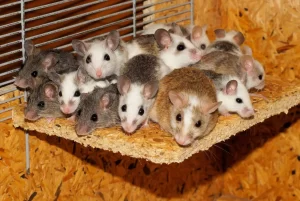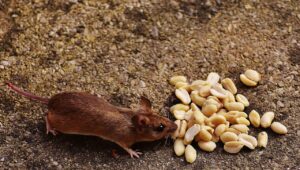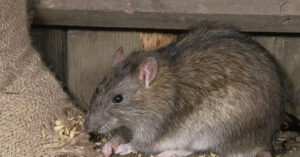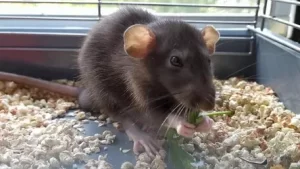
Mice and rodents are small mammals that belong to the order Rodentia, which is the largest order of mammals. They are characterized by a set of continuously growing incisors in the upper and lower jaws, which they must gnaw on regularly to keep them from growing too long. This gnawing behavior is one of the reasons why rodents are often considered pests, as they can cause damage to structures, crops, and stored food.
Here are some common types of mice and rodents:
- House Mouse (Mus musculus): The house mouse is one of the most common rodents found worldwide. It is often considered a pest when it invades homes and buildings in search of food and shelter.
- Rats (Rattus spp.): There are various species of rats, including the Norway rat and the roof rat. Rats are larger than mice and can cause significant damage to crops and structures. They are also known to transmit diseases.
- Voles: Voles are small, burrowing rodents that resemble mice but have a stouter body. They are herbivores and can cause damage to gardens and agricultural crops.
- Squirrels: While not always considered pests, some species of squirrels can become nuisances by raiding bird feeders or nesting in attics.
- Gerbils: Gerbils are small rodents often kept as pets. They are known for their curious and social behavior.
- Hamsters: Hamsters are popular as pets and are characterized by their stout bodies and short tails. They are nocturnal animals and are known for storing food in their cheek pouches.
- Beavers: Beavers are large rodents known for their dam-building activities. They have webbed hind feet and a flat, scaly tail.
Rodents play important roles in ecosystems, serving as both prey and predators. However, in urban and agricultural settings, some rodents can become pests and pose challenges for human activities. Effective pest control measures and proper sanitation are often employed to manage rodent populations and prevent damage. Additionally, some rodents, like hamsters and gerbils, are kept as pets and provide companionship to many people.

Preventing rodent infestations involves a combination of measures aimed at making your living or working space less attractive and accessible to these pests. Here are some preventive measures you can take:
- Seal Entry Points:
- Inspect your home or building for any gaps, cracks, or holes that rodents could use to enter. Seal these entry points using caulk, steel wool, or other appropriate materials.
- Proper Food Storage:
- Store food in airtight containers made of glass, metal, or thick plastic. This helps prevent rodents from smelling and accessing food sources.
- Regular Cleaning:
- Keep your living or working space clean and free of crumbs, spills, and food debris. Regularly vacuum and sweep to remove any potential food sources for rodents.
- Garbage Management:
- Use secure, rodent-proof containers for garbage disposal. Ensure that lids are tightly closed, and consider placing garbage bins away from the main structure.
- Landscaping:
- Trim bushes, trees, and shrubs away from your home to eliminate hiding places for rodents. Keep a clear space between the building and vegetation.
- Pet Food Storage:
- Store pet food in rodent-proof containers, and avoid leaving pet food out overnight. Clean up any spilled pet food promptly.
- Water Sources:
- Fix any leaks and eliminate standing water around your property, as rodents need water to survive.
- Use Rodent-Proof Materials:
- Consider using materials that are more resistant to rodent gnawing, such as metal or thick plastic, for building and storage.
- Regular Inspections:
- Conduct regular inspections of your property for signs of rodent activity, such as droppings, gnaw marks, or nests. Early detection allows for prompt action.
- Professional Pest Control:
- If you suspect or discover a rodent infestation, consider hiring a professional pest control service. They can assess the situation and implement effective measures to control and eliminate the problem.
- Natural Predators:
- Encourage natural predators of rodents, such as owls or cats, in the area. However, keep in mind that relying solely on natural predators may not be sufficient for pest control.
By implementing these preventive measures, you can reduce the likelihood of a rodent infestation and create an environment that is less appealing to these pests. Regular maintenance and attention to potential entry points are crucial in keeping rodents at bay.

Preventing rodent infestations involves a combination of measures aimed at making your living or working space less attractive and accessible to these pests. Here are some preventive measures you can take:
- Seal Entry Points:
- Inspect your home or building for any gaps, cracks, or holes that rodents could use to enter. Seal these entry points using caulk, steel wool, or other appropriate materials.
- Proper Food Storage:
- Store food in airtight containers made of glass, metal, or thick plastic. This helps prevent rodents from smelling and accessing food sources.
- Regular Cleaning:
- Keep your living or working space clean and free of crumbs, spills, and food debris. Regularly vacuum and sweep to remove any potential food sources for rodents.
- Garbage Management:
- Use secure, rodent-proof containers for garbage disposal. Ensure that lids are tightly closed, and consider placing garbage bins away from the main structure.
- Landscaping:
- Trim bushes, trees, and shrubs away from your home to eliminate hiding places for rodents. Keep a clear space between the building and vegetation.
- Pet Food Storage:
- Store pet food in rodent-proof containers, and avoid leaving pet food out overnight. Clean up any spilled pet food promptly.
- Water Sources:
- Fix any leaks and eliminate standing water around your property, as rodents need water to survive.
- Use Rodent-Proof Materials:
- Consider using materials that are more resistant to rodent gnawing, such as metal or thick plastic, for building and storage.
- Regular Inspections:
- Conduct regular inspections of your property for signs of rodent activity, such as droppings, gnaw marks, or nests. Early detection allows for prompt action.
- Professional Pest Control:
- If you suspect or discover a rodent infestation, consider hiring a professional pest control service. They can assess the situation and implement effective measures to control and eliminate the problem.
- Natural Predators:
- Encourage natural predators of rodents, such as owls or cats, in the area. However, keep in mind that relying solely on natural predators may not be sufficient for pest control.
By implementing these preventive measures, you can reduce the likelihood of a rodent infestation and create an environment that is less appealing to these pests. Regular maintenance and attention to potential entry points are crucial in keeping rodents at bay.
